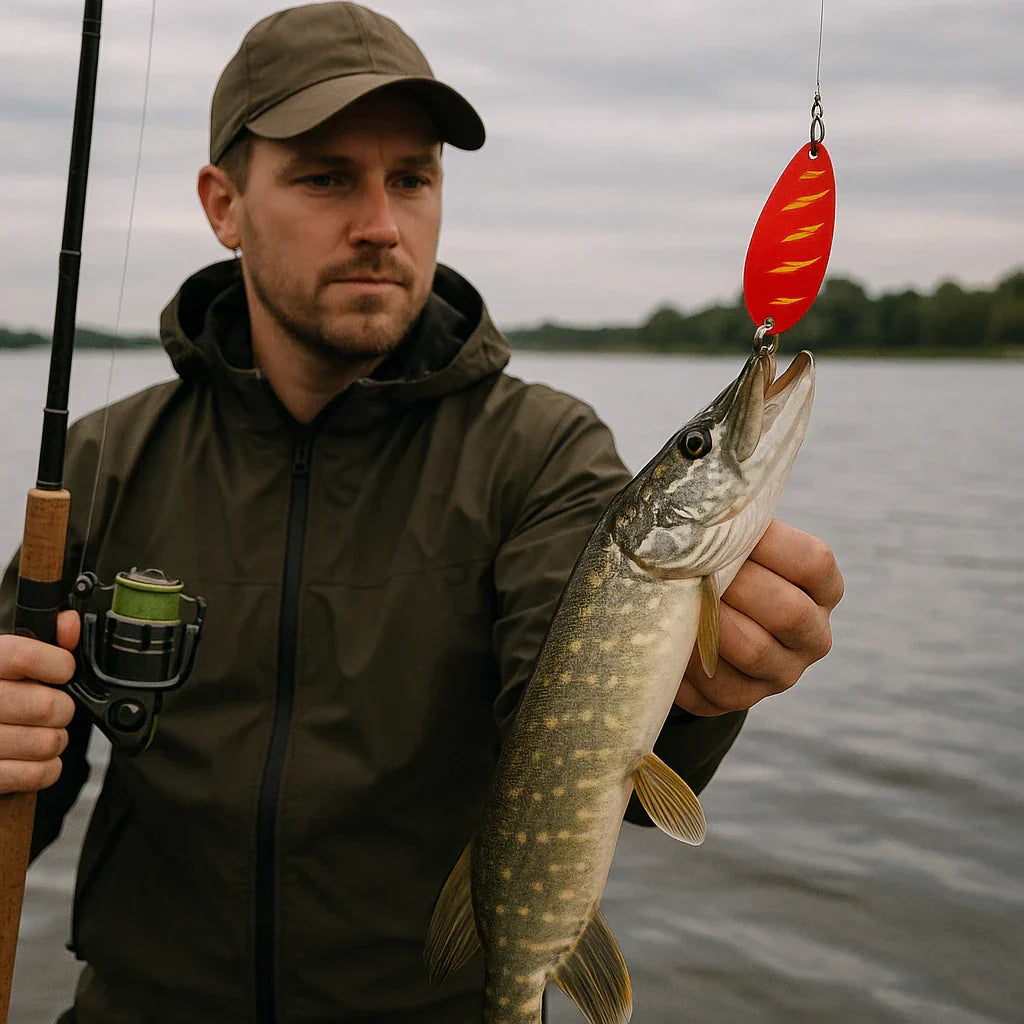Why Metal Spoons Still Matter in Modern Spinning Fishing
Spinning fishing with spinning rods and metal spoons is one of the most exciting and underestimated styles of modern lure fishing. Many anglers tend to focus on soft plastics and wobblers, forgetting that a well-balanced spoon can be just as effective — especially when you know how to retrieve it correctly.
In this article, I’ll share my personal experience with spoon lures — from competition setups to casual spinning fishing sessions. This is the first part of a two-part guide. Here, we’ll cover three basic techniques that help you get the most out of your spoon lures, and in the next article, we’ll move to more advanced retrieves.
The spoon that never goes out of style — Select Grandex 10g.
Even Retrieve – The Simplest Way to Start
The even retrieve (or steady retrieve) is the simplest and most universal way to fish with spinning spoons. The goal is to keep a consistent, smooth motion that makes the lure mimic a weakened baitfish.
The most important thing here is maintaining the right tempo. Move too fast — and the spoon rises too high, leaving the strike zone. After casting, let the lure sink to the bottom, then gently lift it with a small rod tip movement and begin a slow, even retrieve.
When targeting bottom predators like pike or perch, make sure the spoon runs just above the bottom, without touching it. Since spoons use open treble hooks, they easily pick up debris and snag underwater obstacles. The weight of the spoon determines how stable it runs, so choosing the correct one is crucial for precise control.
Realistic trout pattern — Select Solver 10g. Perfect balance of flash and finesse.
Pros and Cons of the Even Retrieve
The biggest advantage of the even retrieve is its ability to cover large areas quickly. When fish are active, this is the easiest and most efficient technique. It’s ideal for scanning a lake or bay to find where pike or perch are feeding.
However, the downside is that it’s not very effective on complex terrain — drop-offs, edges or channels. A spoon keeps running at the same depth it started, meaning you might “fly over” deeper spots where fish are hiding.
Controlling Depth with Pauses
To counter that, add pauses. They not only make your retrieve more varied but also help control depth.
A simple pattern: make 5–7 handle turns, stop, and let the spoon sink. You’ll see or feel the fall through your line or rod tip. Once it touches the bottom — start again. Sometimes you can extend to 10 turns if the water is deeper.
This lets you keep the spoon at the right depth and stay within the feeding zone. It’s especially effective for bottom predators like pike and perch.
🎣 For more control and versatility, explore our full range of lures — from metal spoons to soft plastics and wobblers — each designed for different depths and fish activity levels.
Uneven Retrieve – Acceleration as a Trigger
Another great approach in spinning fishing is the uneven retrieve. After casting, let the spoon hit the bottom and start your slow retrieve. Every 5–6 turns, make a short acceleration — then go back to slow speed.
These bursts of movement work like a trigger: often, pike will strike right after the acceleration. The spoon suddenly “wakes up”, creating a flash and vibration that provoke the predator to attack.
Uneven retrieves are especially good when exploring new water. They help understand fish mood and activity level faster than a monotonous steady retrieve.
Combined Retrieve – Mix of Pulls, Pauses and Lure Kicks
My most frequently used and reliable spoon technique is a combined retrieve — a mix of steady motion, gentle “kicks”, and pauses.
After the cast, let the spoon sink, then lift it slightly and start the retrieve. Every few turns, give a light twitch with the rod tip or a short pull. The lure deviates from its path, wobbles irregularly — and that’s often when pike strikes.
Pauses not only help to control depth but also serve as a moment of provocation. When the lure suddenly stops and then starts again, many fish react instantly.
This method helps determine how fish are behaving today: do they bite on the steady phase, during the pause, or after the kick? Once you figure that out, you can adjust your tempo and pattern — making this technique the foundation for any spinning spoon session.
While metal spoons are excellent for active fish, don’t overlook soft plastic jigs. I’ve covered detailed techniques for triggering lazy predators in Tactics for Catching Passive Pike: An Angler’s Perspective — it’s a great follow-up to this guide.
Where Metal Spoons Work Best
Metal spoons shine on still waters — lakes, ponds, and slow rivers without steep depth changes. For example, in shallow zones around 1.5 m (5 ft), a slow retrieve keeps the spoon perfectly in the strike zone.
On rough terrain or strong current, spoons can still work, but they require more control. That’s where we’ll move next time — to more advanced spinning techniques.

Select ProAtom 15g — bright power for deeper strikes.
Summary
Today we covered three fundamental spinning spoon retrieves — even, uneven, and combined. These techniques form the base for lure fishing with metal spoons and are proven to catch both pike and perch.
In the next article, we’ll explore more advanced spinning techniques, where we’ll increase complexity with tempo shifts, variable pauses, and rod-tip work to imitate wounded or fleeing prey.
🎣 Ready to Try It Yourself?
Discover the full potential of metal lures and see how the right spoon can transform your spinning experience.
👉 Explore our Metal Lures Collection and find your next winning spoon for pike, perch, and trout.



